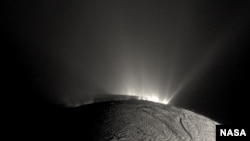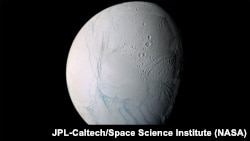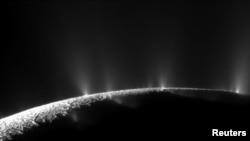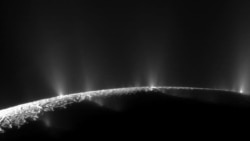NASA has discovered new evidence that Saturn’s moon Enceladus holds material that is important to the early development of life.
The American space agency said the new evidence came from observations made by its Cassini spacecraft. Cassini spent seven years observing seasonal changes around Saturn. During that time, the spacecraft also collected data on Saturn’s moons.
Two of Cassini’s discoveries involved Saturn’s moons Titan and Enceladus. In its observations of Titan, the spacecraft studied the moon’s climate activity and recorded data on rivers, lakes and oceans. Cassini also found evidence of several Earth-like qualities of Titan that could support life.
Another Cassini discovery involved the observation of hydrogen molecules in ice particles and vapor shooting upward from the moon’s surface. Researchers announced that finding in 2017, the same year Cassini officially ended its mission.
In announcing that discovery, NASA scientists said the presence of hydrogen molecules could signal deep-sea chemical reactions between water and rock that could create microbial life.
Now, the space agency is sharing a new finding that supports the earlier discoveries. Scientists examining Cassini data said they identified “strong confirmation” of the presence of another molecule seen as important for enabling life.
Evidence of the molecule – hydrogen cyanide – was found in data relating to the same shooting flows of ice and water vapor observed by Cassini on Enceladus.
The team used data collected by an instrument aboard Cassini designed to measure the activity of gas, ions and ice particles around Saturn. The discovery process involved a lot of mathematics aiming to understand the newly examined data.
The new evidence is described in a study in Nature Astronomy by scientists from NASA’s Jet Propulsion Laboratory (JPL) in California.
The lead writer of the study, Jonah Peter, is currently a doctoral student at Harvard University. He called the discovery of hydrogen cyanide “particularly exciting,” saying the molecule is “the starting point for most theories on the origin of life.”
NASA said in a statement that for life to exist in space, there must be collections of the right building blocks. One of the most important of these is amino acids. “Hydrogen cyanide is one of the most important and versatile molecules needed to form amino acids,” NASA noted.
The researchers said hydrogen cyanide molecules can join together in many different combinations. They can also serve as a “precursor” for different kinds of amino acids.
In addition, the latest examination of Cassini data suggested the underground ocean on Enceladus “holds a powerful source of chemical energy.” The ocean sits beneath the moon’s icy surface.
“Unidentified until now, the energy source is in the form of several organic compounds, some of which, on Earth, serve as fuel for organisms,” NASA said.
Astronomers involved in the research said that the discovery provides fresh evidence that there may be more chemical energy inside Enceladus than previously thought. The more energy that is available, the team said, the more likely it is that life can form and survive.
“Not only does Enceladus seem to meet the basic requirements for habitability,” said JPL’s Jonah Peter, “we now have an idea about how complex biomolecules could form there, and what sort of chemical pathways might be involved.”
The search for possible life on Titan will continue when NASA launches its Dragonfly exploratory mission in 2026. Dragonfly is a drone, or pilotless aircraft. The vehicle is designed to capture images and also land on Titan to collect data.
Tom Nordheim is a planetary scientist at JPL who helped lead the research. He noted that although NASA purposely sent the spacecraft crashing into Saturn’s atmosphere to end its service, Cassini is still proving to be a valuable research tool.
“Our study demonstrates that while Cassini’s mission has ended, its observations continue to provide us with new insights about Saturn and its moons...” Nordheim said.
I’m Bryan Lynn.
Bryan Lynn wrote this story for VOA Learning English, based on reports from NASA and Nature.
________________________________________________
Words in This Story
vapor – n. many small drops of liquid that form in the air
mission – n. an important job or task, often involving travel to somewhere
ion – n. an atom or small group of atoms that has an electrical charge because it has added or lost electrons
origin – n. where something begins or comes from
versatile – adj. using for doing a lot of different things
precursor – n. something that happens or exists before something else and influences its development
insight – n. a thing that helps someone gain a deeper understanding of something
habitability –n. able to support living in or on













Forum